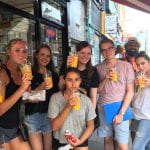While modern-day London is known for demonstrating specifically British heritage and history, it is also an important multicultural center reflective of an international and imperial past. One neighborhood that exemplifies this especially well is Brick Lane, nowadays sometimes referred to as “Banglatown”. This ethnically Bangladeshi area is located in the Shoreditch section of East London, and runs all the
way from Bethnal Green and through Spitalfields down toward Whitechapel. While nowadays, the neighborhood is considered the “cultural heartland” or the British Bangladeshi community, the area has a vibrant and multicultural past, and has been a home to a wide variety of occupants.
To begin, Brick Lane found its name from its 15th century hosts. Unlike in later centuries, at this time, the area was utilized by brick and tile manufacturers from within Britain. However, by the 17th century, this was no longer the predominant trade in the neighborhood— Brick Lane became a very popular spot for breweries above all else. Later in the 17th century, the area received an influx of French Huguenots who had been expelled from their homeland. Next, Brick Lane’s population during the 19th and 20th centuries was comprised of Irish and Jewish immigrants, respectively. Finally, starting in the mid 20th century, Brick Lane became “Banglatown”, signifying the latest cultural and ethnic shift the area has undergone, and one that can still be experienced today.
Even today, though the inhabitants of Brick Lane are less often first-generation Bangladeshis, by entering the area, it can be easily seen that it has held important meaning to its residents and those who resonate with its background throughout its Bangla history. A man named Helal Abbas, who was a councillor involved in the regeneration of the area, commented the following to interviewer Claire Alexander: “I think the symbol… was an issue and a declaration of Banglatown, this gate outside here, was ‘this is our community, we are part of this borough’. Psychologically this was an important Factor.”
By walking the streets of Banglatown today, one can experience a plethora of food and culture within a very small radius. Traditional treats, native to Bangladesh and the Indian subcontinent at large, can be found in numerous locally-owned stores, where friendly shopkeepers are happy to aid customers in selecting from their choice of delicacies. While Bangladesh may be a long and weary flight from the United Kingdom, venturing over to Brick Lane might just be the next best thing.


